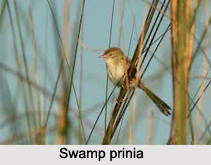 Swamp Prinia or Assam Prinia is an Indian Bird that bears a scientific name "Prinia cinerascens" has the habitat in the riverside areas.
Swamp Prinia or Assam Prinia is an Indian Bird that bears a scientific name "Prinia cinerascens" has the habitat in the riverside areas.
Concentration of Swamp Prinia
Swamp Prinia occurs in the plains of the Brahmaputra River Valley and the Cachar District in the state of Assam, and in nearby parts of northern Bangladesh.
Habitat of Swamp Prinia
Swamp Prinia lives in a variety of habitats with tall grasses or brushes, notably plains of sarkhan (Saccharum) with or without scattered acacias and tamarisks, but also plains of elephant grass and ekra grass, and even deserts with scattered patches of tall grass, and reedbeds. It prefers areas near large rivers or swamps.
Behaviour of Swamp Prinia
Swamp Prinia was locally common, but there have been few recent published reports. Presumably the population is declining because of habitat change. As the rufous-vented Prinia, with which the IUCN combines the present taxon, is rated as near-threatened, the swamp Prinia is considered as a separate species would have that rating or worse.
Structure of Swamp Prinia
Swamp Prinias average 17 cm long. The adult Swamp Prinia are olive-grey above, slightly warmer on the back of the neck and upper back, but less distinctly collared than the Rufous-Vented Prinia. The bold dark streaking of Swamp prinia starts at the forehead and fades on the back. The underparts are greyish-white, greyer on the flanks, which may be slightly streaked. There is a faint buff tint to the under tail coverts (but not the distinctive colouring for which the rufous-vented prinia is named). The upper surface of the wings has barring formed by the covert feathers and their paler fringes. The wing linings are a faintly tawny off-white. The flight feathers of the wings are greyish-brown; when the wing is folded, the primaries barely extend beyond the tertials. Those of the tail may be greyish or olive-brown and have tawny tips. The tail is long and strongly graduated, that is, the outermost pair of feathers is only one-third as long as the central pair. The head shows a conspicuous white eye-ring, whitish lores and dark-streaked whitish cheeks.
Colour of Swamp Prinia
The upper mandible of Swamp Prinia is horn-brown; the lower, straw-brown or flesh-brown. The eyes are brown, varying a little in lightness. The legs are flesh-coloured or pale brown.
Plumage of Swamp Prinia
From July to September the plumage is worn, especially the tail, which may be much shorter than in fresh plumage and missing the tawny tips. The moult is usually complete by October.
Juvenile Swamp Prinia
The juveniles Swamp prinias are similar but have loose, fluffy plumage. They have little or no streaking on the back and their tail tips are rufous, not tawny. They molt into adult head and body plumage, retaining their flight feathers, about 4 to 6 weeks after fledging.
Call of Swamp Prinia
The calls include "a wheezy feez, and a quiet, very rapid nasal rattle." The song is described as a warble about 4 seconds long, liquid and loud, comparable to that of a dunnock.



















